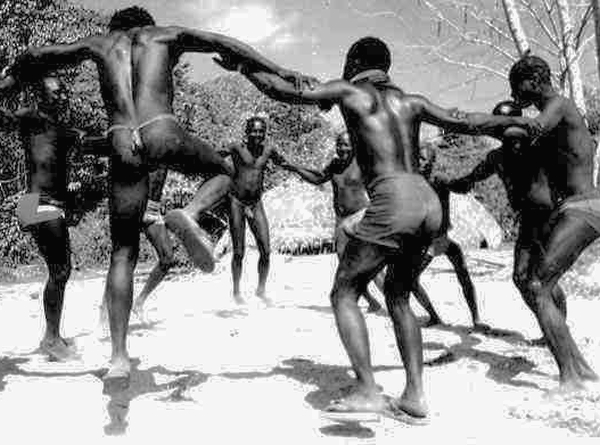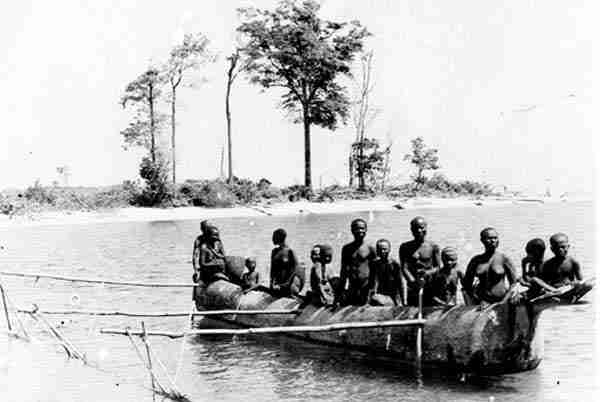So far we have mentioned Andamanese tribes and other groups such as the Great Andamanese, the Onge, Jarawa and Sentineli, without explaining what these groups are and, as far as they have survived, still are. The tribes are not tribes in the way this word is normally understood: they had no power structure, no chiefs, no tribally-owned territory, no clans and not much in the way of revered common tribal ancestors. Indeed, it is easier to define their tribes by what they are not, rather than by what they are.
Basically, each Andamanese tribe is merely a collection of independent local groups that speak the same language, share a common culture and tradition and are bound to each other by bonds of friendship or enmity. There is no tribal terri-tory, only a number of hunting territories each owned by a local group. That the Andamanese were fully aware of the linguistic basis of their tribes is shown by the fact that all Greater Andaman tribal names contain the prefix Aka-, Akar-, A- or Oko-. In the various tribal languages these meant "pertaining to the mouth" or "language." A member of the Akar-Bale tribe, therefore, was someone coming from the tribe speaking the Bale language.
The first outsiders to take a scientific interest in the Andamanese and to write down their findings were not aware of the existence of any sub-divisions among them. The Andamanese were thought to be one large tribe, all speaking the same language. It took the permanent settlement of 1858 for the British to realize that this was not so. Much of what had at first been thought to be unpredictable be-haviour - friendly one day and hostile the next - turned out in the light of growing knowledge to have been contact with more or less closely related but quite sepa-rate and independent groups. Initially, every newly-discovered group was called a "tribe." When more and more were found, confusion reigned for a few decades until it was realized that there was a hierarchy of groups. It started with the nucle-ar family at the bottom and went up through the local group (a few) via the "sept" (a few friendly local groups) to the largest unit known somewhat inaccurately as the tribe (a collection septs, some friendly, some hostile. Early literature is full of confused references to local groups, septs and tribes, the terms often used inter-changeably. We will discuss the social units below the tribe in another chapter and the rather different split of the tribes into Aryoto (shore-dwellers) and Er-emtaga (forest dwellers) later in this chapter. Suffice it to say that because of the very limited geographical mobility of individuals living within their local groups, traditional life took place almost entirely within remarkably narrow social and geographical limits.
There is not much to be gained by listings local groups and septs within the dif-ferent tribes. The lists compiled were necessarily incomplete, before the 1890s because not all groups were known and after that time because all accessible groups were rapidly dissolving. None of the Onge-Jarawa groups had at that time been studied in any depth and even today their internal structuring is far from clear. It is also conceivable that there have been entire tribes that died out from disease before they could be recorded. The Jangil discussed later in this chapter seem to be such a case, and there could have been others.
As a purely linguistic and cultural entity, the traditional tribe was not an entity rel-evant in the daily life of a traditional community before 1858. When communica-tion, intermarriage and travel between the tribes increased did they assume a greater importance. In 1980 of the 23 surviving Great Andamanese tribes (all of mixed Indian/Burmese/Andamanese ancestry) one person each claimed Aka-Cari, Aka-Kora , A-Pucikwar and Akar-Bale while three claimed Aka-Bo and the remainder Aka-Jeru tribal affiliations. Because of intermarriages with Indians and Burmese as well as between different Andamanese tribes, these claims had no cultural or other practical meaning but are a source of pride on the part of a peo-ple on the edge of extinction.
During happier timers, there was a grouping above the tribe: there were ten Great Andamanese tribes on one side and the four tribes of the Jarawa-Onge group on the other. In the only place where these groups touched was in the southern part of Great Andaman. There the Aka-Bea and the Jarawa fought each other in a bitter jungle war for what may have been centuries before the British arrived. The differences between the Andamanese at all levels groups must have evolved more or less in situ over a long period of time. It seems likely that, once they had arrived in the islands by whatever means, the various groups diverged more and more while staying in roughly the same place. We will discuss these and other questions relating to Andamanese origins and prehistory in a later chapter.
The differences between the Onge language on the one hand and the Great Andamanese languages on the other are considerable. A vocabulary of several hundred Onge words was found to share less than a dozen common roots and stems with the Great Andamanese. The relationship also not obvious and can be brought to light only by a detailed linguistic analysis.
Although clearly related in varying degrees, the tribal idioms were (and those surviving today still are) quite distinct and separate languages. They should not be called dialects. Linguistic change in static societies is slow and there cannot have been many societies more static than those of the traditional Andamanese. On linguistic grounds alone, therefore, the tribes must be ancient. They differ not only linguistically but also in many cultural details: from the form of their huts, their bows and arrows, their canoes, their ornaments, their utensils, their traditions. In the following chapters we shall try to explain some of the more obvious and important differences between them.
5.1 The Great Andamanese
It is conventional practice to classify the Greater Andamanese into two or three groups: the northern and the southern groups with sometimes a middle group added. This classification is convenient but is based more on geography than linguistic or cultural criteria. The ten tribes of this group clearly and obviously form one closely related group.
The Greater Andamanese languages formed a linguistic continuum from north to south with neighbouring languages more closely related than those further away from each other. The Aka-Bea and Akar-Bale languages were closest, being mutually intelligible to some extent. It is known that the two tribes felt closely related and the names they had for each other (as listed in the table below) confirm this. While most Great Andamanese tribes had practically no contact with each other, the two southernmost tribes are known to have had what in Andamanese circumstances must be called intensive relations before 1858. Whether we have here an example of a tribe in an early stage of the process of splitting into two smaller tribes must remain an open question.
At the other extreme within the Great Andamanese grouping, the differences between Aka-Bea in the south and Aka-Cari in the far north were substantial and the two languages - in the unlikely event of individuals meeting before 1858 - would have been mutually unintelligible.
The differences between the Great Andamanese languages involved mostly the vocabulary and pronunciation rather than grammar and syntax. The myths and legends of all the Great Andaman tribes also give the same picture: they differed in many details but were recognizably from the same stock. The so-called Wot-a-emi legend is particularly interesting. The legend related the belief (common to the tribes living around the A-Pucikwar: the Aka-Bea, Akar-Bale, Aka-Kol and Aka-Kede) that the fire was acquired from the mythical being Biliku at Wot-a-emi on Baratang Island in A-Pucikwar territory. The A-Pucikwar were regarded as the original tribe and they were called "the people who speak Andamanese." Our Sources do not name the tribes that did not know of this legend - it could hardly have been current among those who were not aware of the A-Pucikwar's exist-ence.
The Great Andamanese had an apparently irrepressible tendency to split into ever smaller units. Before the British arrived, there was little contact between the various tribes. Each tribe was not unlike a self-contained, self-sufficient and rather self-satisfied club with membership figures of between 200 and 700. Yet even these tiny tribelets managed to split still further into the minuscule sub-groups of jungle-dwelling and shore-dwelling septs that did not mix much The possible existence of a third sub-group of creek-dwellers within the Eremtagas, might indicate that at least the forest dwellers were in the process of splitting up still further. The year 1858 put an end to it all.
One is left to wonder just how far the Great Andamanese, had they been left to their own devices, would have carried the process of splitting. Taken to its ultimate degree, it would have meant the self-extinction of the race. Whence this extraordinary urge to commit what looks like a form of slow communal suicide? Their often violent dislike of outsiders, of things foreign and of having their traditional way of life disturbed in any way was an adaptation that had been successful at preventing outsiders from overrunning the islands. While such xenophobia would have been a useful defensive adaptation, it may well have grown out of control to the point when the "we and they" among Andamanese groups became so restricted that it excluded all but the members of the local group and a few friendly neighbouring groups. However this came about, it was the situation the British found in 1858.
It is true that among Greater Andamanese, local groups situated directly at the tribal border show some evidence of cross-border traffic but nothing is known on the nature of such contacts. We only have a brief report on linguistic seepage across tribal borders, colouring the local dialect on either side of it.
Very little is known, too, about the cultural differences between the ten Great Andamanese tribes. Best known from the writings of Man and Portman are the Aka-Bea. Later researchers investigating the northern tribes could only try to salvage what they could from groups that were close to dissolution. Radcliffe-Brown, our major source for the northern tribes, was primarily interested in presenting his interpretation of the available evidence and only secondarily in the collection of new data. He tended to refer to the northern tribes as a whole, showing more interest in what they had in common than it what divided them. To the Greater Andamanese themselves, their tribal differences, of course, loomed large and seemed enormously important - until the truly different outsiders moved in.
Today, all that is left of the Greater Andamanese is a sad group of roughly two dozen people living on Straits Island reservation with their material needs taken care of by Indian government social workers. Their language is a mix of at least Aka-Jeru and A-Pucikwar with a very strong and growing component of Hindi. The essentially new language is sometimes called Aka-Jeru but is so different from the original Aka-Jeru that it would better be called "new Aka-Jeru" or "new Great Andamanese." Indian sources also often just call it, rather confusingly, "Andamanese."


